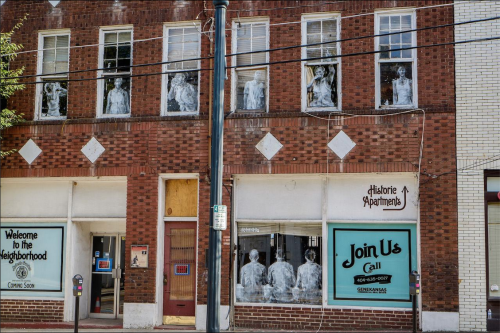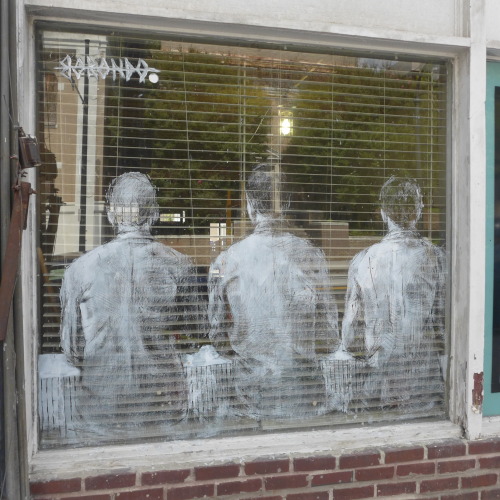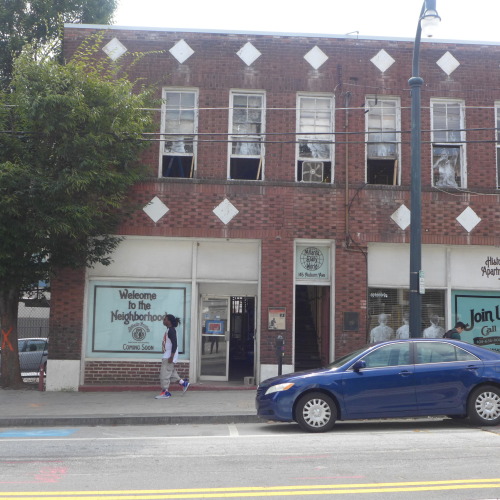
Over the summer, on a building at 145 Auburn Avenue, you might have noticed three figures in the ground-floor window, their backs to the street, as if engaged in a sit-in at a lunch counter. On the second floor, another series of figures seemed to call out to the people below, as if petitioning them to hear their story.
It is a story of resistance and remembrance that Spanish artist Borondo aimed to tell in his contribution to Living Walls, the annual citywide project that uses public surfaces as canvases for art. In June, Borondo came to Atlanta and, while searching for a building for his next mural, learned about the Atlanta Daily World newspaper and its civil rights history.
That story began in 1928, when William A. Scott, a 26-year-old Morehouse graduate started the Daily World, which soon became the nation’s first African-American daily, on the city’s most affluent black street, Auburn Avenue. Covering many important issues affecting the nation such as racism, segregation and police brutality, the paper encouraged the community to get involved with campaigns such as registering to vote and supporting local businesses. The Daily World’s print circulation would slowly decline throughout the years, dropping to 16,500 in the 1980s, from 22,000 just two decades prior. By 2000, its circulation was only 10,000. But even after the building was severely damaged by the tornado that year, the paper survived. Alexis Scott, William’s granddaughter, was its last publisher and editor. In 2012, the Daily World merged with Real Times Media and continues to have a strong digital presence.

Gene Kansas, a commercial real estate developer and preservationist purchased the building from the Scott family earlier this year and is spearheading its renovations. Until recently, any investment on Auburn Avenue was considered risky, given its long history of neglect by property owners and the city, but the revitalization efforts of the Old Fourth Ward, the BeltLine, and the promising new trolley are turning the neighborhood around. Kansas is making room for apartment units on the upper level. Local shops Condesa Coffee and Arden’s Garden will take up residence below.
Kansas recognized the important history of the building and believed it was worth saving. A native of New Orleans, a city that takes great pride in maintaining its cultural roots, Kansas sees the Daily World building as more than just an old structure in need of a facelift. “The news was reported here and was at the forefront of important ideas. In effect, Borondo’s art is telling [the building’s] story.”
For his Living Walls project, Borondo painted the nine figures in white on the windows. It was apparent that the bodies were not just residents but activists. The figures on the lower level sat on stools, their backs rigid and their head facing forward, focused and determined. Upstairs, six figures, one per window, overlooked the street, each posed differently: hands cupped around their mouths, as if shouting, or standing still as if surveying the scene.

The windows have since been removed. The ground floor piece will be displayed inside a new Condesa Coffee location, which is slated to open in January in the Daily World building. Kansas says that “the second story windows will travel,” though details were not forthcoming.
Unfortunately, we live in a city that often turns its back on the past to make room for future endeavors like upscale shopping developments and luxury condos. But it is the visible remains of our history that remind us of our past, our triumphs and mistakes. Imagine, no Fox Theatre, or Martin Luther King, Jr. Birth Home, or Margaret Mitchell House. And there are many historical sites in the city that can’t be imagined because even local residents don’t know about them, usually because of their ruined state. The Atlanta Preservation Center lists more than two dozen endangered historical sites. With community activism and support from the city, there have been success stories. The Glenn Building on Marietta Street, which was transformed into the Glenn Hotel in 2006, and the Peter’s House, now SCAD’s Ivy Hall, on Ponce de Leon Avenue are just two examples.
The Atlanta Daily World is not just another building. Its history tells an important story.
Are we listening, Atlanta?
Annabella Jean-Laurent is an Atlanta-based freelance writer who blogs at militantbarbie.com. Her writing explores race, media, and gender in society.
This project is supported by the Georgia Humanities Council and the National Endowment for the Humanities and through appropriations from the Georgia General Assembly.





